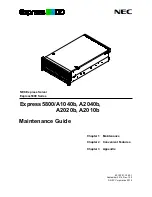Reviews:
No comments
Related manuals for UCS 5100

NEC Express5800 Series
Brand: NEC Pages: 4

NEC Express5800 Series
Brand: NEC Pages: 21

NEC Express5800 Series
Brand: NEC Pages: 10

NEC Express5800 Series
Brand: NEC Pages: 22

NEC Express5800 Series
Brand: NEC Pages: 71

NEC Express5800 Series
Brand: NEC Pages: 166

NEC Express5800 Series
Brand: NEC Pages: 16

x3655 - System - 7985
Brand: IBM Pages: 118

C00LE
Brand: Wyse Pages: 6

UniServer BT716F
Brand: H3C Pages: 44

GTT-400
Brand: GlobalTime Electronic Pages: 19

SUPERSERVER 5018D-MF
Brand: Supero Pages: 120

PRIMERGY TX140 S2
Brand: Fujitsu Pages: 86

PRIMERGY TX150 S3
Brand: Fujitsu Pages: 95

PRIMERGY TX150 S6
Brand: Fujitsu Pages: 118

primergy TX150
Brand: Fujitsu Pages: 305

PRIMERGY TX150 S6
Brand: Fujitsu Pages: 127

PRIMERGY TX140 S2
Brand: Fujitsu Pages: 332


















